
|
Greatest Scariest T |
| Movie Title/Year and Brief Scene Description | |||||||||||||||||||||||||||||||||||||||||||||||||

|
The Tenant (1976, Fr.) (aka La Locataire) #66 Roman Polanski's suspenseful psychological thriller about insanity and paranoia had many similarities to his two previous films, Repulsion (1965) and Rosemary's Baby (1968). Shy and aloof bureaucrat, French citizen and Polish-born immigrant Trelkovsky (director Roman Polanski himself, although uncredited), a displaced foreigner, moved into a squalid Parisian apartment vacated by a previous tenant, an Egyptologist named Simone Choule. The previous occupant had attempted to commit suicide by jumping out of the window from the balcony. She was subsequently hospitalized (with a body cast in traction, an almost toothless mouth and bandaged head). When Trelkovsky visited her, he met Simone's friend Stella (Isabelle Adjani), who was also at the bedside. The bandaged patient let out a disturbing howl and scream, and died shortly later. As the film progressed, Trelkovsky was seemingly viewed with suspicion, hostility and contempt by his apartment neighbors (mostly elderly), who often complained that he made too much noise. He seemed to feel guilty about living in the suicidal victim's apartment. He became preoccupied with the previous tenant Simone's suicidal and self-destructive tendencies as well as her habits (he was compelled to adopt her breakfast choice of chocolate (instead of coffee) and cigarette brand of Marlboros). He often saw other tenants standing motionless and staring back at him from the communal bathroom across the way. He found a bloody tooth in a hidden hole in the wall (plugged by cotton) behind the heavy wardrobe - and later discovered that it was a perfect match to a second tooth - the missing molar in his own bloody mouth. He slowly became hostile, paranoid, and demented (and possibly schizophrenic) and obsessively transformed (mentally and physically) into Simone (i.e., by cross-dressing with one of Simone's dresses in an armoire, some high-heeled shoes and an ill-fitting wig that he bought). He also was sexually inadequate with Stella - reminiscent of Simone's disinterest in men. He exhibited other disturbing behaviors. For no reason, in a park, he slapped a defenseless child in the face (who had lost his boat in the pond), calling him a "filthy little brat." A bouncing soccer ball outside his window turned into a decapitated human head. He watched as the other tenants humiliated another disfavored tenant (wearing a joker hat and his own masked face). He stabbed at a hand reaching in through his apartment window, and cut his hand on the glass.
He feared that other tenants in his apartment building were plotting a conspiracy, persecuting him, and changing him into the previous tenant so that he would repetitively follow her behavior and commit suicide: "They forced her to commit suicide, I can prove it, and they're trying to do the same thing to me...They've been trying to turn me into Simone Choule." Deranged and becoming self-destructive like Simone when he channeled her, he attempted to commit a more successful suicide (as himself and the previous tenant) by hurling himself from the window. Cross-dressed, a drum-roll anticipated his leap to the pavement, and he crashed through a recently-repaired glass atrium that shattered. Trelkovsky was severely injured and lying on the concrete, where the neighbors found him and wondered whether he was "insane," fixated, had a "brain storm," and was unusually disturbed. He imagined his neighbors rabidly encouraging him to hurt himself. Battered with a broken leg and bleeding, he dragged himself away from them and up the stairs, while calling them a "gang of killers." He taunted the spectating onlookers and showed disgust, defiance and resolve:
The crowd of onlookers was amazed to see him at his apartment window again - jumping and falling to his death. [Note: At the instant of his death (?), did he imagine himself associated with the mummified 'patient' from the earlier scene?] In the next enigmatic, replicated (or mirrored) scene when the story had gone full circle, Trelkovsky was back in the hospital with Stella, visiting a bandaged patient - the same scene from the film's beginning. From the POV of the patient, the two spoke to "Simone." Stella asked frantically: "Don't you recognize me?" As the patient let out the same disturbing cry (heard when they visited before), the camera zoomed into the blackness of the patient's mouth as the film ended.
However, one must ask - was the patient Simone - or Trelkovsky? Was Trelkovsky reliving or reidentifying with his earlier hospital visit from Simone's perspective, that of the mummified "patient" looking up at Trekolvsky himself? Some theorists speculated that Trelkovsky was only an imaginary character created in the mind of the insane, hospitalized Simone. |
 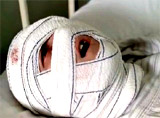  Bandaged Suicidal and Screaming-Dying Simone Choule   Cross-Dressing as a Woman ("I Think I'm Pregnant") 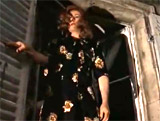    First Suicide Attempt  2nd Attempt |
|||||||||||||||||||||||||||||||||||||||||||||||

|
#82 Director James Cameron's sleeper film (only his second feature film), co-written with producer Gale Anne Hurd, was an exciting, well-paced action thriller with apocalyptic themes, a threatening monster, and adventure story elements. In the film's start, time traveler and human resistance fighter-leader Kyle Reese (Michael Biehn) experienced frightening memories of a post-apocalyptic future in the year 2029, in a ruined Los Angeles, a scene of annihilation and devastation ("nuclear fire") where AI machines ruled the world, led by a computer network called Skynet. He recollected the infiltration of the resistance's human hideout by another future Terminator (Franco Columbo). In the main story, two time travelers were sent back from the future year of 2029 and appeared in Los Angeles of 1984:
The Terminator's objective was to eliminate Sarah Connor (Linda Hamilton), who would one day be the mother of a son (an off-screen John Connor) who would lead a human Resistance movement-rebellion against the evil cyborg leaders of Earth's future. In one chilling scene, Reese struggled with a resistant Sarah in their car while being pursued. He entreated: "Come with me if you want to live," and warned:
During the Terminator's relentless pursuit, it performed two surgeries upon itself (his damaged forearm and his left eye) after crashing a stolen police vehicle. The final scene was a face-off in a factory between Sarah Connor and the relentless Model 101 cyborg 'Terminator' - reduced to a metallic, skeletal frame after a fiery oil tanker-truck explosion. The unstoppable cyborg's metal exo-skeletal frame (with glowing red eyes) was all that remained. After having its lower half blown away, it crawled and grasped towards her with its remaining hand. She escaped death by strangulation, by luring the cyborg underneath a massive hydraulic press and crushing it.
As she pressed a red START
button to initiate the process, she yelled out: "You're terminated,
f--ker!" The glowing red eyes of the Terminator dimmed and extinguished. |
 The Infiltration of Hideout by Future Terminator (Franco Columbo)   The Arrival of Terminator T-800  Reese to Sarah: "It can't be reasoned with" 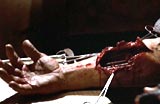  Two Self-Surgeries |
|||||||||||||||||||||||||||||||||||||||||||||||

|
Terminator 2: Judgment Day (1991) This science-fiction blockbuster, also by James Cameron, was a well-executed, action-packed sequel to the earlier film of the same name. The film opened, under the credits, with frightening images of the disturbingly-realistic depiction of a fiery, nuclear weapon blast exploding in Los Angeles in late summer, 1997. While institutionalized in 1995 after attempting to blow up Cyberdyne Systems, and for acting delusional and insane over thoughts of an apocalypse, clairvoyant, muscular warrior woman Sarah Connor (Linda Hamilton) was videotaped explaining her apocalyptic visions:
Later, after her escape from the hospital, she experienced further nightmarish, end-of-the world cataclysmic dreams, in which she envisaged the fiery effects on a children's playground and herself. White light ignited everything like match heads as she saw her dream self burst into flames and her skin burned away. Los Angeles landmarks were pulverized as the shockwave of the blast hit the downtown area. The howling wind blasted apart the once-human figures of bone and ash. Sarah's own figure exploded down to skeletal remains.
She was the single mother of rebellious John Connor (Edward Furlong), now a pre-teenager and foster child - and the child-savior of future humanity in a war with a deadly machine complex called SkyNet. The fatherless boy was threatened by a seemingly-indestructible, liquid-metal, shape-shifting Terminator android named T-1000 (Robert Patrick), with no emotional intelligence, usually exemplified as a policeman. He had the uncanny ability to 'morph' his body into any solid shape, impersonate other persons and even camouflage himself with the background. An older model Terminator T-800 (Arnold Schwarzenegger), now re-programmed as a protective, monotone-speaking, motor-cycle riding Cyberdyne Systems cyborg, was sent from the future to protect the boy.
Some viewers were disturbed by the many impalement scenes:
|
   Terminator T-800     Terminator T-1000 |
|||||||||||||||||||||||||||||||||||||||||||||||

|
Terminator 3: Rise of the Machines (2003) In this third film (the second sequel) in the series from director Jonathan Mostow, the revised (but "obsolete design"), mono-syllabic speaking Terminator Model T-850 (Arnold Schwarzenegger), powered by two hydrogen fuel cells, was designed and reprogrammed (by the Resistance) to protect 20-something post-apocalyptic leader John Connor (Nick Stahl) and his future Resistance-second-in-command wife Katherine (Kate) Brewster (Claire Danes). Connor described the Terminator T-850 as "a robot from the future, he's living tissue over a metal skeleton." In opposition to them was an even more impressive Terminatrix (T-X) (Kristanna Loken) - a female, superhuman, sophisticated model ("a far more effective killing machine"), sent back to the year 2004 in modern-day Los Angeles. It had an arm that could morph into dangerous weapons ("The T-X is polymimetic, able to take the form of anything it touches"), and was highly lethal. She could determine the identity of a person immediately with a sample of blood (DNA), and she had other advanced scanning capabilities. She could also remotely control various machines (including auto vehicles). The T-X was:
In one of the action film's most startling scenes, the T-X was impersonating Kate Brewster's slain fiancee Scott Mason (Mark Famiglietti) in order to locate John Connor. "Scott" thrust his arm through the heart of the car driver in order to grab the steering wheel from the back seat of the police car. The film's conclusion included a thrilling one-on-one fight between the two Terminators (in the hallway, men's room and storeroom), ending with the deaths of the two Terminators at Crystal Peak. After the fierce struggle that had left the T-X with detached legs, the Terminator detonated his last hydrogen fuel cell in the female T-X's mouth, destroying both of them ("You are terminated!") |
  T-850 (Arnold Schwarzenegger) 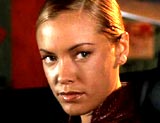   Terminatrix, or T-X (Kristanna Loken) |
|||||||||||||||||||||||||||||||||||||||||||||||

|
Terminator 3: Rise of the Machines (2003) In the finale, future liberators Katherine (Kate) Brewster (Claire Danes) and John Connor (Nick Stahl) discovered that Crystal Peak was merely a protective 30 year-old government fall-out shelter for VIPs, designed to survive a nuclear blast. SkyNet (composed of cyberspace software) couldn't be shut down or destroyed with explosives ("There was never any stopping it"), as nuclear missiles were being launched and detonated. Annihilation by SkyNet was inevitable. In the film's downbeat ending, nuclear missiles across the world were being launched and detonated by the rogue artificial intelligence SkyNet on Judgment Day. It was an awe-inspiring, scary nuclear annihilation of the world that was being conducted in the outside world. John assumed command from the underground command post and spoke to Montana Civil Defense on the radio, as the film ended with his voice-over:
|
   Apocalyptic Launching of Nuclear Missiles |
|||||||||||||||||||||||||||||||||||||||||||||||
 The Texas Chain Saw Massacre (1974)  The Texas Chainsaw Massacre 2 (1986)  Leatherface: Texas Chainsaw Massacre III (1990)  Texas Chainsaw Massacre: The Next Generation (1994)  The Texas Chainsaw Massacre (2003)  The Texas Chainsaw Massacre: The Beginning (2006)  Texas Chainsaw 3-D (2013) |
#5
Director Tobe Hooper's grindhouse horror classic, a real rural nightmare, was originally shot in 16mm, giving it a raw, documentary feel. However, it was loosely based on the true crimes of grisly, notorious Wisconsin serial killer Ed Gein. There were numerous sequels to the original 1974 Texas Chainsaw Massacre film, stretching over almost 40 years!
The original, low-budget 1974 seminal horror film hinted at the massacre of young people to follow, although it was fairly bloodless, surprisingly. It actually had less gory chainsawing scenes than might have been expected, although it was full of bashings, hackings, and impalements - usually beginning with Leatherface jumping out of the shadows. The tagline asked:
It opened with a sober narration about a crime spree - vandals desecrating graveyards in a remote section of Texas, although it was not based on a true incident. The movie's main character became a seminal bogeyman - a masked, relentless, psychotic, chain-saw wielding, hulkish butcher-killer known as Leatherface (Gunnar Hansen), with a mask made of skin. Leatherface was part of a crazed, inbred family of psychopathic cannibals who ran a human meat-packing plant. Leatherface was both repulsive and muscular, in his Grand Guignol pursuit of victims. A small group of five young hippie Texans would soon become Leatherface's victims - they were enroute to the possibly-vandalized grave of grandfather Hardesty. The five main characters were:
After visiting the gravesite, while on their way to the Hardesty homestead, they picked up a scary-looking hitchhiker (Edwin Neal), later revealed as Leatherface's brother, who cut himself with a pocket-knife, and also slashed Franklin on his arm with a straight-edged razor. They stumbled upon a small house while awaiting a delivery of gasoline at the local service station, where the slaughter was about to begin. The film's most indelible image was of a sliding door that opened and took battered, innocent teenagers into the lair of the chainsaw-wielding Leatherface, wearing a butcher's apron and a stitched, human-skin mask.
In the concluding lengthy scene, Sally Hardesty (the sole survivor) was bound and gagged, and held captive at the clan's dinner table. Her finger was cut and served as a bloody appetizer for the weakened, withered, vampiric and patriarchal Grandfather (John Dugan)). As she watched in horror while being restrained, she saw the Grandfather suck on her wounded finger. She was about to serve as the "dinner" main course for the deranged clan of captors.
The Grandfather was given a hammer to strike at Sally ("Hit that bitch!"), who was forced to kneel in front of him with her head over a large metal bucket, but he was too weak to do any harm. During the chaotic scene, she escaped by plunging through a window and frantically running down the farmhouse road, while being chased by the hitchhiker (Leatherface's brother) and Leatherface himself (dressed as a woman). The former was gruesomely run over by a semi-truck. With a bloodied face, Sally screamed at the horrific sight as the body was crushed by the huge truck tires. She was able to climb into the red cab of the semi, as Leatherface approached with his churning chainsaw. Sally fled again out the other side of the cab with the frantic driver, and hailed down a passing pickup truck. She jumped into the back, and with a bloody and deranged-look, she laughed as the spinning Leatherface - in the golden dawn - swung his buzzing chainsaw through the air in a frustrating, exaltant dance. |
 Leatherface (Gunnar Hansen)  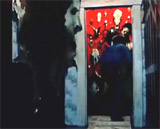 Kirk's Bludgeoning by Leatherface   Pam's Snatching and Meat Hook Hanging 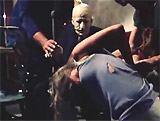 Jerry Sledge-Hammered  Franklin Sliced in Stomach   Sally Taking Flight From House   Leatherface's Brother Run Over by Truck - and Sally's Reaction    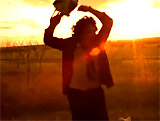 Sally's Escape - The Only Survivor |
|||||||||||||||||||||||||||||||||||||||||||||||

|
Theater of Blood (1973, UK) Douglas Hickox's campy black comedy-horror film from American International Pictures was originally titled Much Ado About Murder, and was obviously inspired by the success of star Vincent Price's Dr. Phibes movies. It reportedly required over six gallons of fake blood for the eight ghastly yet creative murders (see below), with a total body count of eleven. The demented, macabre film was mostly a series of elaborate and flamboyant Shakespearean death scenes. The film's tagline warned:
Egotistical and vain Shakespearean actor Edward Lionheart (Vincent Price in an over-the-top role) received poor reviews for his performances and stage adaptations from the theatrical Critics Circle. After he was passed over for the coveted Critic's Circle award for Best Actor, he apparently committed suicide - although his own death by drowning was faked (he was rescued from the Thames River). Then, the deranged, humiliated and murderous mad-man exacted deadly revenge on his nasty, London theater critics who had snubbed him and ended his career, with parodies of deaths from the last season of his Shakespearean plays. In many of the cases, Lionheart underwent numerous costume and hairstyle changes, while recreating the various roles for which he was criticized - as a doctor-surgeon, as a Scottish masseur, as a French chef, as a fencing instructor, as a camp hairdresser (with a huge afro wig), named "Butch," etc. Lionheart also gloriously gave a hammy recital of the words of Shakespeare as each of the critics met a dastardly demise. In the film's fiery conclusion, as Lionheart perished in the flames of the burning theatre, he was given a eulogizing, wry and cynical send-off by critic Devlin:
|
 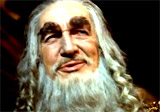   Edward Lionheart (Vincent Price) |
|||||||||||||||||||||||||||||||||||||||||||||||
|
|||||||||||||||||||||||||||||||||||||||||||||||||

|
Them! (1954) #72 Gordon Douglas' sci-fi horror film reflected the time period of the Cold War mid-1950s, when a new era of testing dangerous atomic weapons in the mid-1940s was feared to have caused mutations. It was one of the most classic mutant monster B-flicks. The main terror facing mankind were ants that had mutated into giant creatures - the only other species that engaged in war: ("Ants are the only creatures on Earth other than man who make war. They campaign. They are chronic aggressors"). The eerie film was filled with scary suspense for the first half hour. It opened in the New Mexico desert, where police sergeant Ben Peterson (James Whitmore) and his partner Ed Blackburn (Chris Drake) found a traumatized five or six year-old girl (Sandy Descher) (later identified with the last name of Ellinson) wandering trance-like, carrying her doll. She did not talk and appeared to be in shock. The child was found near a station wagon automobile next to an almost-destroyed house trailer (with Illinois plates) with a metal hull that was unusually "caved out" instead of "caved in." There were no footprints or tire marks (except one unidentifiable animal track), no evidence of burglary, and no bodies - but lots of cubelets of sugar scattered around. While lying in an ambulance and about to be taken to a hospital, a peculiar, vibrating sound prompted the girl to sit up, transfixed and staring blankly into space, but then the high-pitched, pulsating sound ended and she laid back down - without being noticed. Twelve miles away was "Gramps" Johnson's General Store, also ransacked and destroyed but no evidence of burglary. There was a bent-barrelled 30-30 shotgun behind the counter, and the store owner (Mathew McCue) was found dead under a trap door that led to an underground storeroom ("Looks like he was dragged and thrown down there"). A gaping opening on one side of the store "wasn't pushed in, it was pulled out just like at the trailer." And a large wooden barrel of sugar was knocked down and open, and the sweet powder was being consumed by small ants.
When Blackburn was left alone at the murder scene, the loud, high-pitched sound began again - and as he went to investigate, shots (and screams) were heard from off-screen when he was presumably attacked and killed. The officers learned that the mobile home was owned by an FBI agent named Alan Ellinson from Chicago vacationing with his family (wife and two children). FBI agent Robert Graham (James Arness) from Alamagordo, NM was called in, and reported that the animal of the plaster cast foot print couldn't be identified; it was sent to the FBI's headquarters in Washington, DC for analysis; the County's Medical Officer Dr. Putnam (Joseph Forte) determined that Gramps' cause of death was from multiple causes: a broken neck and back, a crushed chest, a skull fracture, and "enough formic acid in him to kill 20 men." Two scientists (ant entomologists) from the Department of Agriculture in Washington DC arrived: Dr. Harold Medford (Edmund Gwenn) and his pretty daughter Dr. Pat Medford (Joan Weldon); Medford theorized that the case might have something to do with recent 1945 atomic testing in the White Sands area of the New Mexico desert near Alamogordo ("Yes, genetically, it's certainly possible"). At the hospital, the young girl was revived out of her shocked state by a sniff of formic acid provided by Dr. Medford, and she screamed: "THEM! THEM!!!! THEMM!!!!"
In the desert during a raging sandstorm at the site of the destroyed trailer, Dr. Medford discovered a second animal track over 12 centimeters - making the creature over 8 feet in length; Medford was reluctant to state his preliminary conclusions: "This is monstrous...something incredible has happened in this desert. ln which case, none of us will dare risk revealing it, because none of us can risk a nationwide panic."
While exploring on her own, Pat found more tracks and heard the strange pulsating sounds; she screamed when one giant ant attacked her from behind and was able to attract the attention of the others; Dr. Medford urged the officers to shoot at the ant's antennae to disable it: ("Get the antennae! Get the antennae! Get the other antenna!...He's helpless without them"), before it was pulverized with submachine gun fire. Dr. Medford identified the creature as a mutation - a race of giant radioactive and carnivorous ants with large mandibles had decended from a radiated ant: "Species appears to be Camponotus vicinus. Of the family of Formicidae. An ant...A fantastic mutation. Probably caused by lingering radiation from the first atomic bomb"; its odor of formic acid was what triggered the girl to violently react, and Gramps' corpse was filled with the substance after being injected through the ant's stinger: "Ants use their mandibles to rend, tear and hold their victims but they kill with that, by injecting formic acid." The Medfords both suggested locating the colony of the foraging "scout" ant that was communicating with others: "We must find the colony, the nest"; Dr. Medford offered a Biblical prophecy: "We may be witnesses to a Biblical prophecy come true - 'And there shall be destruction and darkness come upon creation, and the beasts shall reign over the earth.'; he also speculated that there might be "several hundreds to several thousands" of ants in the colony's nest, but probably fewer since they just recently appeared or developed. The cone-shaped mound of the nest was located from the air - it was a deep hole in the desert ground; the remains of "missing persons" (the Ellison family, Officer Blackburn) were scattered around the opening - consisting of skulls, other bones and a gun holster belt.
During a hearing, Dr. Medford suggested that they wait to bomb the nest until the next day - the hottest part of the day when the ants would all be inside; at that time, the nest's opening was bombed and burned with bazookas and the tunnels were then gassed with cyanide; to determine the results, Pat, Graham, and Sgt. Peterson rappelled into the nest and its deep tunnels to explore; they found dead ant carcasses and used flamethrowers to kill one ant who had survived the gas before they located the Queen Ant's chamber with two empty, hatched eggs; Pat ordered everything incinerated: "Now destroy everything in here. Burn it!"
Back on the surface, Dr. Medford was worried that two young Queen Ants had hatched and escaped, and would now mate and produce further nests: "These two empty egg cases contained queen ants. Newborn queen ants have wings, so have their consorts, male ants....Two young queen ants hatched out, dried their wings and flew away, each with one or more winged males. They've gone on their wedding flight...We've only had a close view of the beginning of what may be the end of us." During secret meetings and instructional sessions with Washington officials in DC, Dr. Medford was even more pessimistic with a prediction if the situation wasn't brought under control: "Man, as the dominant species of life on Earth, will probably be extinct within a year."
Further unusual sightings or disturbances included a report from Brownsville, Texas by ranch foreman Alan Crotty (Fess Parker) who crashed his plane after sighting three ant-shaped flying saucers - he was placed in a mental institution for observation and questioning; and another news item was reported about the S.S. Viking infested with giant killer ants traveling from Acapulco, Mexico to Singapore; the ship was sunk with naval gunfire to prevent further infestation. Two troubling incidents were also reported in Los Angeles - probably the result of the two hatched Queen Ants: (1) 40 tons of sugar had been stolen from a railroad car, and (2) a father named Thomas Lodge died and his two sons Jerry and Mike mysteriously disappeared while they were flying a model airplane in LA's concrete river basin near the opening to 700 miles of storm drain sewer tunnels below the city; trying to get away in his car, Lodge died of shock and blood loss after his arm was torn off at the shoulder, and he had a deep laceration across his chest. Martial law and a curfew were issued for the city of Los Angeles, and an informative descriptive news bulletin was broadcast over TV about the emergency:
During a rescue attempt with the cooperation of the Army (Jeeps were driven into various sections of the LA tunnel system), Sgt. Peterson rescued the two threatened boys by aiming his flamethrower at the giant ants, but then was killed by one of them when grabbed around the waist with its giant mandibles.
After many of the other giant ants were obliterated, Dr. Medford learned that new princess ants or Queens had not yet hatched underground and escaped from the nest's chamber; he ordered the chamber's destruction in Drain # 267 with bazookas and flame throwers: ("Fortunately, we're in time. l'm certain no new queens have escaped from this nest. The job will be done when these are destroyed"). The film concluded with Robert Graham's question to Dr. Pat Medford about further atomic tests after 1945 and their effects on other ants: "What about all the others that have been exploded since then?"; more ominous words (the film's final line of dialogue) were delivered her father: "Nobody knows, Robert. When Man entered the Atomic Age, he opened a door into a new world. What we'll eventually find in that new world, nobody can predict." |
  The Young Traumatized Girl (Sandy Descher) Mysterious Evidence:  Ransacked Trailer  Cubes of Sugar   The Vibrating Sound of the Ants Caused Girl to Sit Up  Just Before Officer Blackburn's Death  FBI Agent Robert Graham (James Arness)  Dr. Harold Medford (Edmund Gwenn)  Dr. Pat Medford (Joan Weldon)   First Full Views of the Foraging Creature 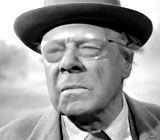 Dr. Medford's Ominous Warning: "We may be witnesses to a Biblical prophecy come true..."  A Map of a Typical Ant Nest with Tunnels   Bombing the Nest and Gassing It with Cyanide  Dr. Medford's Dire Prediction of Man's Extinction  Emergency TV Broadcast About the Threat of Ants Below Los Angeles in the Storm Sewer Tunnels  Jeeps Driven Into Storm Drain Tunnels  Two Boys in Danger of Giant Ant Attack  The Burning of the Nest's Egg Chamber Under LA  Graham's Question to Dr. Pat Medford  Her Father's Answer |
|||||||||||||||||||||||||||||||||||||||||||||||

|
The Thing (From Another World) (1951) #48 UFO sightings and reports of flying saucers or strange visitors from outer space found their way into Hollywood features as allegories of the Cold War, such as in director Christian Nyby's and producer Howard Hawks' sole science-fiction film The Thing From Another World (1951). The influential and taut horror and science-fiction B-film hybrid was one of the earliest examples of an alien invader film, and featured filmdom's first space monster. It was a tale told to illustrate how scientists had foolishly meddled with things that shouldn't have - and caused further catastrophe. The film effectively focused on character interaction, with natural and rapid-fire dialogue, appropriate scientific jargon, and a strong-willed female character named Nikki Nicholson (Margaret Sheridan). The three most memorable moments of the classic film were:
A group of isolated scientists led by researcher Dr. Arthur Carrington (Robert Cornthwaite) were stationed in a remote Arctic scientific research base in the vicinity of the North Pole. Military pilot Captain Patrick Hendry (Kenneth Tobey) was sent to investigate the crash landing of an unidentified flying object (UFO) near the base. The group of scientists and military men discovered an extra-terrestrial, flying saucer UFO buried deep in the tundra ice in a circular-shaped crash site, along with an eight-foot alien-humanoid life form encased in a frozen block of ice. After removing the frozen humanoid shape from the ice, they brought it back to their research station headquarters. The Thing creature accidentally defrosted or thawed (with an electric blanket) and escaped, and proceeded to kill the sled dogs and hunt down the scientists themselves for their blood. They realized that the alien creature was a killer, chlorophyll-based humanoid vegetable (TV's Gunsmoke star James Arness), and slightly radioactive. Two of the researchers were discovered in the greenhouse, hanging upside down with their throats slit. Carrington unwisely argued that he was studying and researching the rapid growth rate of the alien despite the danger, and that he wished to preserve the alien at all costs. When it was determined that the alien had to be eliminated, its presence was thrillingly announced by crew chief Bob's (Dewey Martin) beeping, flashing Geiger counter. In the tense sequence, it was coming closer and closer - and was revealed behind a closed doorway. When the tall monstrous creature finally appeared, it was doused with kerosene and set ablaze with flare guns. It swatted away the men while on fire, and found an escape through a window into the snow before running off. In the thrilling conclusion set in the generator room, the alien was electrocuted by 3 large arcs of electricity when he walked on a grid-trap, and was reduced to disintegrating ashes.
The influential film's last line of dialogue from Anchorage reporter Ned 'Scotty' Scott (Douglas Spencer) warned in a closing broadcast about America's 50s-style suspicions of the world:
|
     The Appearance of the Alien Humanoid - Set Ablaze with Kerosene |
|||||||||||||||||||||||||||||||||||||||||||||||

|
Director John Carpenter's remake of the 1951 Howard Hawks' classic, was considered to be the first part of a so-called "Apocalypse Trilogy," followed by:
The film's premise about an alien threat was set at a remote Antarctica base, US Station 31. The action began with the shooting of a beastly sled dog that viciously attacked - it was discovered to be a shape-shifting alien that could assimilate itself into the shape of its victims. It was feared that if the alien ever escaped to a civilized area, it would assimilate all of life on Earth in only a few years: ("This thing doesn't want to show itself. It wants to hide inside an imitation. It'll fight if it has to, but it's vulnerable out in the open. If it takes us over, then it has no more enemies, nobody left to kill it, and then it's won"). The film's tagline warned:
In the autopsy scene, infected Norris (Charles Hallahan), a member of the Antarctica research team experiencing sub-zero temperatures during a snowstorm and extreme paranoia, had a heart attack. As the camp's Dr. Copper (Richard Dysart) attempted to revive his heart with resuscitation paddles and CPR, Norris' mutated rib cage/chest and stomach broke open. It became a fanged, gaping maw with a bear-trap spring that bit off the doctor's forearms. In addition, Norris's head reached up to the ceiling, and as he was incinerated, his head separated from his body and dropped to the floor, where it sprouted spindly spider legs and eye stalks to scurry away like a crab. It was then incinerated by R.J. MacReady's (Kurt Russell) flame-thrower.
In another exciting yet scary sequence, the creature had begun to assimilate itself with meterologist Bennings (Peter Maloney) - the crew discovered him as only a half-changed mutant (with mis-shapened, arachnid-like arms) when they cornered him outside and he bellowed back at them. Within a circle of the men, MacReady incinerated Bennings by overturning a large canister of fuel and igniting him. MacReady explained to doubting Garry (Donald Moffat): "It was one of those things out there trying to imitate him, Garry." Also there was tense scene when everybody was forced to take a blood serum test in the rec room: ("We're gonna draw a bit of everybody's blood. We're gonna find out who's the thing"). It was implemented by MacReady and Windows (Thomas Waites) upon the participants who were forced to sit together while tied by heavy rope in chairs as they had their thumbs sliced open - in order to 'smoke out' the alien creature. Each one's blood was tested with a heated piece of copper wire. When MacReady tested the blood of helicopter pilot Palmer (David Clennon), the blood sample reacted violently, and the infected victim's face exploded outward, and his body was propelled into the ceiling tiles. When it fell, its deformed head split vertically to shockingly reveal an eyeless tentacled monster. With its main tentacle emerging from what was its head, it massacred, mauled and strangled Windows until finally incinerated by MacReady's flame thrower. The burning creature smashed through the outer wall and fell in the snow, where MacReady blew up its remains with a stick of dynamite. There was an additional scary scene of discovering that Blair (Wilford Brimley), slowly going insane (and probably also infected), had escaped the locked and isolated storage shed by tunneling under the ice. The only way to insure the camp's survival for the only two remaining, MacReady and Childs (Keith David), was to annihilate the base by exploding it to smithereens with dynamite. As MacReady set the charges, the monstrous, snarling, big-toothed creature - now appearing Godzilla-like from under the ground (and giving birth to another sled dog), threatened him, but he was able to succeed in his mission (he hurled dynamite at the creature, with parting words: "F--k you too!"). MacReady and Childs discussed how futile survival was and how they probably wouldn't make it, given the circumstances: "Why don't we just wait here for a little while, see what happens?" (the film's last line from MacReady)
|
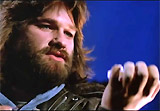  MacReady Testing Blood Serum Samples       Palmer Was Infected and Incinerated   The Monstrous Big-Toothed Creature |
|||||||||||||||||||||||||||||||||||||||||||||||

|
The Tingler (1959) This was a classic horror film by 50s B-film director and impresario schlockmeister William Castle, who introduced the film's prologue with this word of advice:
Castle's speech was followed by zoomed-in examples of disembodied screaming heads - three in all. Vincent Price portrayed mad, part-time pathologist/scientist Dr. Warren Chapin who made the discovery that the tingling sensation one felt running up and down one's spine when afraid was actually a "living" parasite that grew and lived in the vertebrae. When one couldn't scream or when one experienced prolonged scary situations (without having the therapeutic release of a primal scream), the parasite could grow to enormous size and cripple a person:
A gruesome experiment was conducted on Chapin's deaf-mute patient Mrs. Martha Higgins (Judith Evelyn), the wife of silent movie theatre owner Oliver Higgins (Philip Coolidge) - a friend of Chapin's.
She was scared by repeated hallucinatory shocks in her apartment's bedroom and throughout her house:
During Martha's autopsy, Dr. Chapin extracted the squirming, lobster-like centipede from her body, and for a brief moment, it attached itself to his arm. As he napped on the couch, the Tingler also crawled onto Dr. Chapin's chest and threatened to choke him. It released itself when his socialite wife Isabel Stevens Chapin (Patricia Cutts) returned home and screamed!
Dr. Chapin explained his theory about how the spine “tingled” when experiencing fear, due to the presence of a parasite attached to the spine that would grow during a fear episode. The only antidote to neutralize or kill the host and/or prevent it from growing was to scream as loud as possible. He also surmised that if he returned the Tingler to Martha's corpse, it would die:
Later in the film's climax, Dr. Chapin planned to place the Tingler back into Martha's corpse, but of course, the boxed creature escaped and entered a crowded film theater showing the silent film Tol'able David (1921). After scaring one young female by climbing up her leg, the Tingler crawled into the inattentive projectionist's booth. In pitch black, Chapin tried to calm the theatre audience with an announcement: "There's no cause for alarm. A young lady has fainted. She is being attended to by a doctor and is quite alright. So please remain seated. The movie will begin again right away."
On screen, the projected film broke as the silhouette of the Tingler moved across the projection beam. The film theater went pitch black. The film audience (within the film and watching the film) were encouraged to scream to lessen the effects of tingling fear during a long black-out section by the voice of Dr. Chapin:
To enhance the effect when the Tingler was on the loose in the theatre, seats were rigged with vibrating devices to produce the tingling effect - a gimmick nicknamed Percepto. After Chapin made another reassuring announcement, "The Tingler has been paralyzed by your screaming. There's no more danger. We will now resume the showing of the movie," he rushed to the projection booth where the projectionist was being strangled by The Tingler. His screams caused the creature to drop to the floor, where it was captured in a film canister. In the film's conclusion, Higgins received the same fate as his wife, who had the Tingler reinserted into her spine by Dr. Chapin to neutralize its effects. The Tingler resurrected Martha who rose up and caused her husband to also die of fright - with muted screams. Dr. Chapin's words (in darkness) ended the film:
|
 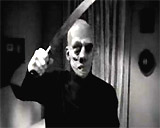 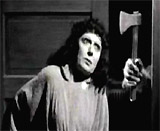      The Death of Martha    The Film's Conclusion: Martha Was Resurrected With The Tingler Reinserted, and Her Husband Oliver Higgins Died of Fright |
|||||||||||||||||||||||||||||||||||||||||||||||
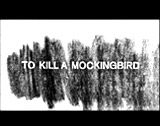
|
This highly-acclaimed film featured a dramatic tour-de-force of acting, with a portrayal of childhood innocence (told from a matured adult understanding), and a progressive, enlightened 60s message about racial prejudice, violence, moral tolerance and dignified courage. The innocence and world of play was exhibited by tomboyish six year-old Scout (Mary Badham) and her ten year-old brother Jem (Phillip Alford), who were being raised by their widower attorney father Atticus Finch (Gregory Peck). They often fantasized about a 'boogeyman' recluse who inhabited a mysterious house in their neighborhood, nick-named "Boo" Radley. They were abruptly brought out of their insulated and carefree world by their father's unpopular but courageous defense of a black man named Tom Robinson (Brock Peters) falsely accused of raping a Southern white woman. Racism doomed the accused black man, although there were still prejudiced adults in the neighborhood. In a scary nighttime scene near the film's climax, Jem and Scout had just attended a Saturday night costume pageant in the town's school building. Scout wore a giant ham costume (for Halloween), because she had lost her dress and shoes: "I'll feel like a fool walking home like this." At almost 10 o'clock, they walked home (with a moving camera position) through the dark wooded area between the school and their home, as the trees and leaves rustled around them. Stopping and starting, Jem repeatedly believed he heard heavy footsteps walking behind them in the eerie, Southern gothic sequence. To confront their ghost, Scout yelled out an echoing retort: "I'll bet it's just old Cecil Jacobs tryin' to scare us. (Yelling) Cecil Jacobs is a big wet hen." Jem guided his sister with a hand on her costume while looking back and hearing distinct footsteps. A shadowy form attacked Jem and hurled him to the ground. As she struggled to get out of her awkward, cumbersome ham costume, Scout was thrown down and rolled around inside the protective outfit. She heard scuffling, grunting, kicking, and pounding sounds as Jem wrestled against his attacker and shouted: "Run, Scout!" He was seriously injured and rendered unconscious. When the assailant turned toward Scout, a second pair of hands intervened from an unseen man - they wrestled with her attacker and came to her defense. Through the view-hole of the ham, Scout watched in wide-eyed horror as the scuffling sounds of a second struggle died down and there was silence. Scout was prevented from seeing an attacker (the feared Boo Radley?) assaulting her brother. From her point of view, she watched a pair of legs cross her path and under a street light, she saw Jem's limp body being carried home by a mysterious person. After removing her costume, Scout followed closely behind and saw her brother being carried into the Finch yard. They were unexpectedly delivered from real harm, although Jem suffered a badly-fractured arm. The Sheriff revealed a disturbing find in the woods, the body of disgraced and vengeful Bob Ewell: "Bob Ewell's lyin' on the ground under that tree down yonder with a kitchen knife stuck up under his ribs. He's dead, Mr. Finch....He's not gonna bother these children any more." As Scout related what had happened, she noticed a man in the corner of the bedroom behind the door - she identified him as the one who grabbed Mr. Ewell and carried Jem home: "Why, there he is, Mr. Tate. He can tell you his name..." In fact, they were rescued by the reclusive neighbor, Mr. Arthur "Boo" Radley (Robert Duvall). |
      The Attack on Scout in Giant Ham Costume  "Boo" Radley (Robert Duvall) - Scout's Protector |
|||||||||||||||||||||||||||||||||||||||||||||||

|
Torn Curtain (1966) Hitchcock's Cold War political espionage thriller included a very prolonged sequence in which a man was murdered (with no music on the soundtrack) - it was the most famous part of the film, made doubly more suspenseful by having the audience feel complicit in the death. The main star was Paul Newman as Prof. Michael Armstrong - an American physicist who was also a secret double agent who had defected to East Germany, holding secrets of an American missile research program. Armstrong realized that he had to eliminate a Soviet agent - his own German "bodyguard" policeman/security officer Hermann Gromek (Wolfgang Keiling), who was suspecting his duplicity. The lengthy, nasty and brutal murder sequence in a farmhouse kitchen outside of Berlin involved the difficult killing (with one's bare hands) of Gromek by Armstrong, with the assistance of farm wife (Carolyn Conwell). The murder had to be accomplished quietly, in order to avoid arousing the suspicions of the taxi driver (Peter Lorre) waiting outside. The farmer's wife and Armstrong both wordlessly conveyed to each other that they had to eliminate Gromek. When the farm wife picked up Gromek's gun, she glanced out of the window and when she saw the taxi driver, she realized that she must set the gun down and use a knife instead - a quieter method.
There were multiple stages in the lengthy, slow, awkward, and immensely problematic struggle to murder the strong, intimidating Gromek, who bragged: "Cut it out. Don't be stupid. I was trained by experts":
The oven gassing was deliberately filmed from various angles - from both a high-angle and low side-angle, as Gromek was dragged across the floor. There were realistic closeups of heads, hands, and faces - concluding with a grim overhead shot above the oven. |
   Asphyxiation of Gromek in a Gas Oven |
|||||||||||||||||||||||||||||||||||||||||||||||

|
Twilight Zone: The Movie (1983) Nightmare at 20,000 Feet, a segment of John Landis' 1983 anthology film (directed by George Miller), was originally part of Rod Serling's TV show, The Twilight Zone (specifically episode # 123, or Season 5's Episode # 3, that aired in mid-October 1963). It was a half-hour segment directed by Richard Donner with William Shatner playing the lead role of Mr. Robert Wilson. The story was first published as a short story by Richard Matheson in Alone by Night (1961). Rod Serling's original opening and closing TV narrations in 1963 were remarkable:
In the original 1963 version, Mr. Wilson's problems were blamed on a nervous breakdown. In the remade segment, the protagonist was suffering from severe flying phobia (aviatophobia). It began with this narration (by Burgess Meredith):
In the tense, remade scene, phobic airplane passenger John Valentine (John Lithgow) was trying to settle down and relax in his airplane seat, suffering from a panic attack. Looking out the aircraft window, he deliriously saw a weird and hideous gremlin (Larry Cedar) sitting on the wing above one of the jet turbines. He watched in horror as the gremlin appeared to be damaging or sabotaging the outer engine during a turbulent storm. Lightning bolts struck the engine and the gremlin, causing a fire. Other passengers strained to look out the same side of the plane, as he babbled to himself and everyone else:
He was outwardly disturbed and his condition bothered others, as flight attendants attempted to calm him down and give him a sedative to sleep. Valentine was given a red blanket and reassurance, and his airplane window shade was closed.
Then, he dared to take another look -
The plane was met by police and medical crew, who straitjacketed the seemingly-insane Valentine and put him in an ambulance. In the ironic ending, maintenance workers noticed evidence of unexplained damage to the plane's engines. |
 Mr. Robert Wilson (William Shatner) in an Episode of the Original TV Show Twilight Zone   "There's a Man on the wing of this plane!" |
|||||||||||||||||||||||||||||||||||||||||||||||
(alphabetical by film title, illustrated) Intro | #s-A | B | C-1 | C-2 | D-1 | D-2 | E | F | G | H I-J | K-L | M | N-O | P | Q-R | S-1 | S-2 | S-3 | T | U-Z |